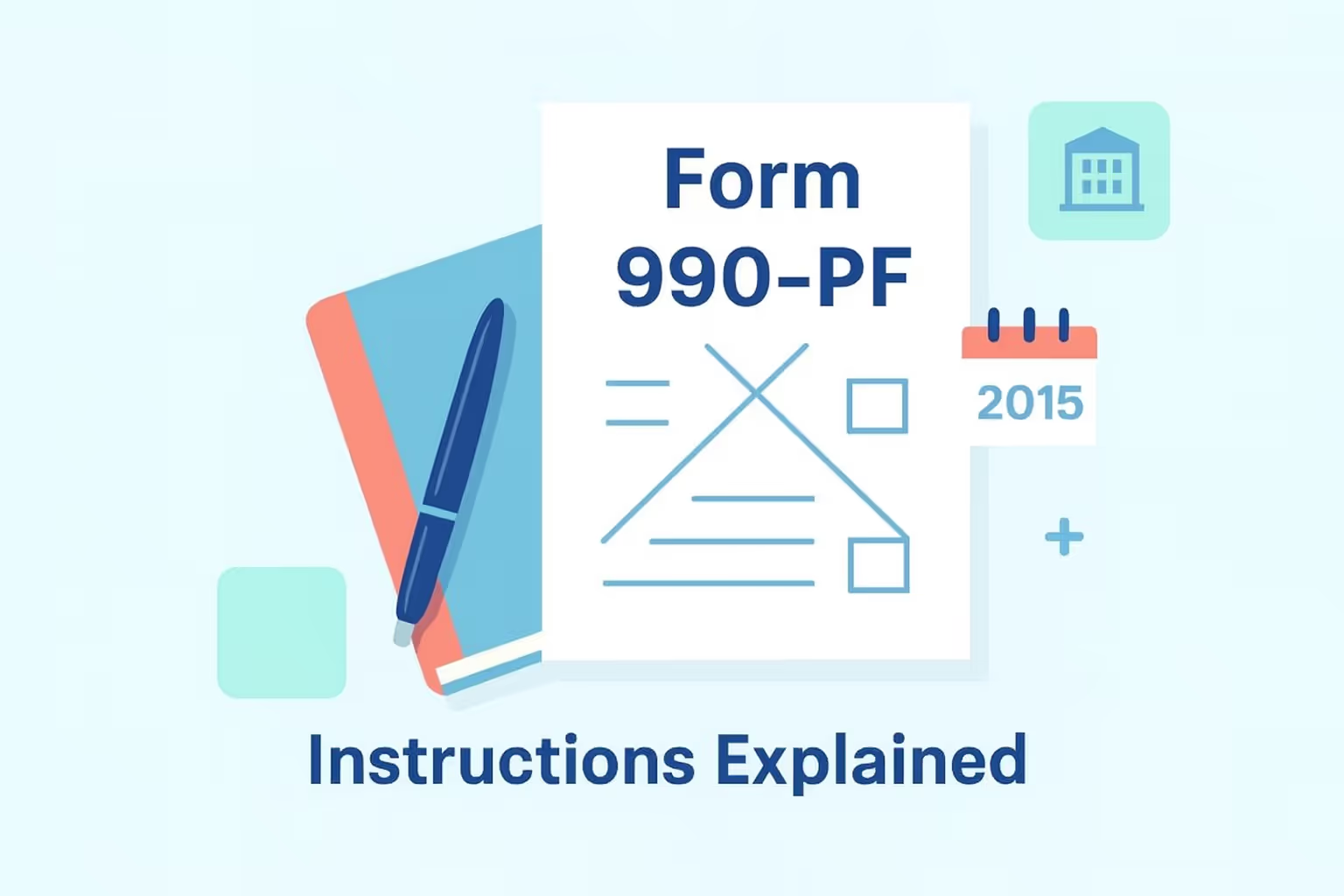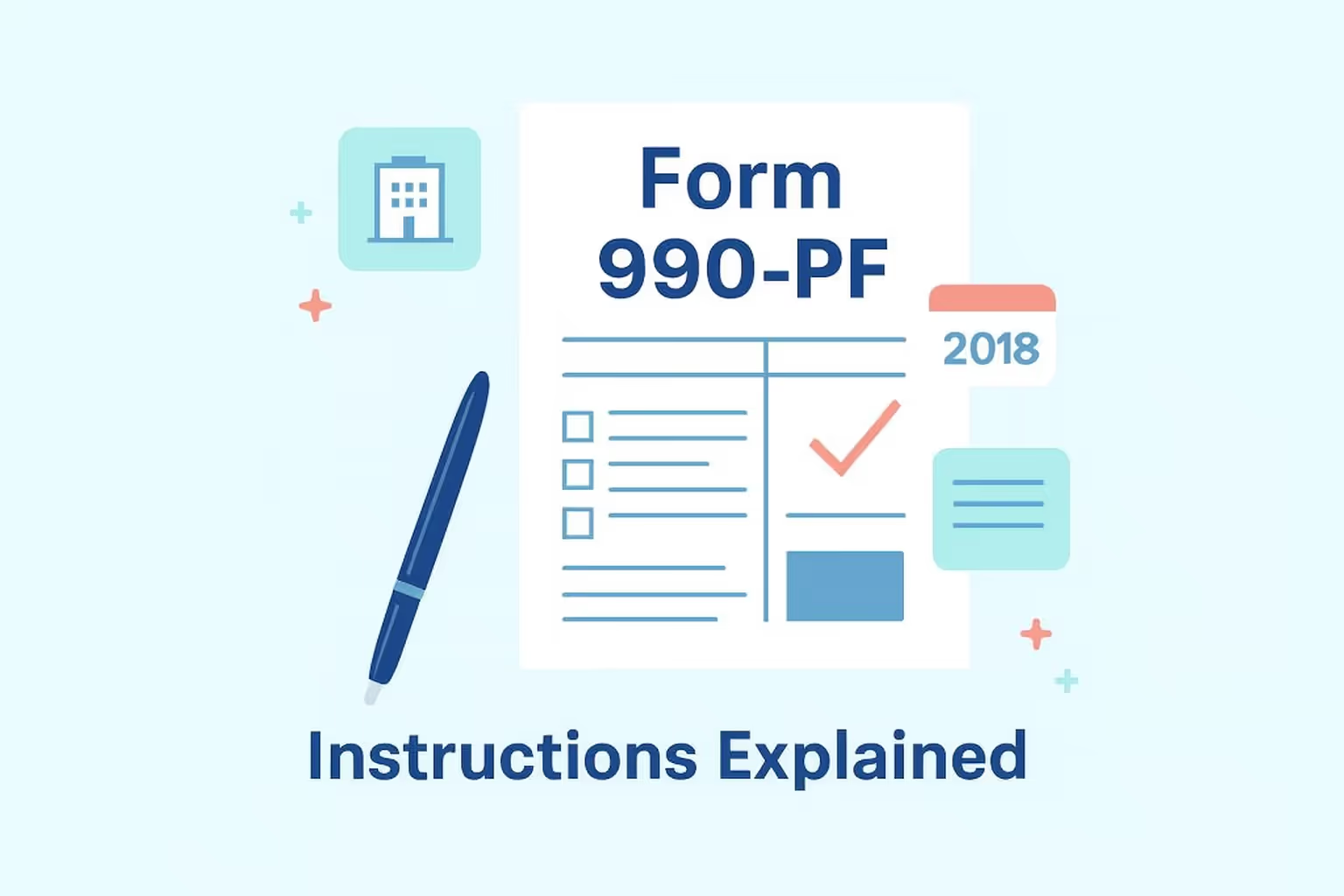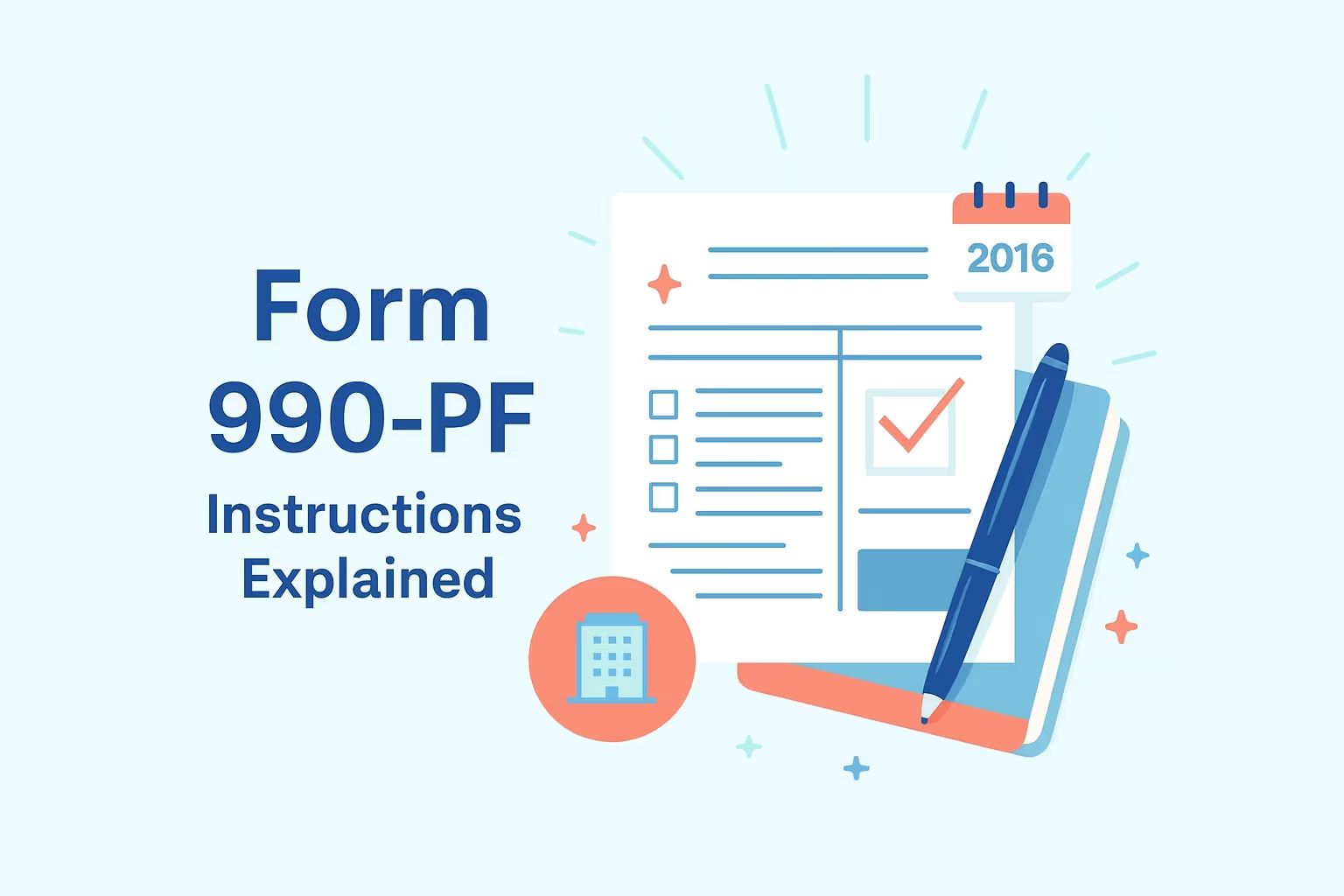Form 990-PF Filing 2015: IRS Instructions for Foundations

The Form 990-PF filing requirements for 2015 outline how private foundations must comply with federal rules while maintaining their tax-exempt status. This return of a private foundation is a detailed document used by the Internal Revenue Service to monitor nonprofit organizations, confirm eligibility for tax exemption, and assess compliance with reporting standards. For leaders of tax-exempt organizations, trustees, and board members, understanding this filing process is crucial to maintaining tax-exempt status and avoiding compliance issues.
Private foundations play a critical role in supporting charitable activities, distributing funds, and promoting exempt purposes. When completing the private foundations return, organizations are asked to disclose information about charitable distributions, gross receipts, capital gains, and net assets. These details allow the Internal Revenue Service to evaluate financial support and ensure that philanthropic organizations remain aligned with their stated primary purpose. Filing also provides transparency to the public, creating accountability for how contributions and program-related investments are managed.
For many nonprofit organizations, the process can feel overwhelming. The terminology, schedules, and additional requirements tied to federal income taxes may seem challenging to navigate. This guide is designed to simplify the process step by step, explain filing expectations, and help organizations meet their responsibilities under the Taxpayer Act. By breaking down each element into clear instructions, private foundations can strengthen their compliance while continuing to support charitable programs that rely on their resources.
Form 990-PF 2015 Instructions and Purpose
Form 990-PF serves as the annual return for private foundations and remains central to maintaining their tax-exempt status. The Internal Revenue Service requires nonprofit organizations to file this form to evaluate tax compliance, confirm exempt purposes, and track financial support. By filing the form accurately, charitable organizations demonstrate transparency, report philanthropic distributions, and sustain the trust of donors, board members, and the public.
- Form 990-PF return: This return must be filed by all private foundations, including nonexempt charitable trusts treated as foundations. It documents gross receipts, capital gains, net assets, and charitable distributions, allowing the Internal Revenue Service to evaluate whether the organization’s accounting period and operations meet exemption requirements.
- Tax-exempt organizations: Organizations recognized under Section 501(c)(3) must file Form 990-PF if classified as private foundations—failure to file for three consecutive years results in the automatic revocation of tax-exempt status. Once revoked, the foundation becomes taxable and subject to federal income taxes until the exemption is restored.
- Purpose of disclosure: The form captures details about contributions from a single contributor, grants awarded, and program-related investments, requiring trustees and directors to demonstrate how funds and resources support charitable activities while advancing the foundation’s primary purpose. This reporting process ensures that charitable organizations remain accountable to both regulators and the public.
- Financial transparency: Reporting income tax liability, gross receipts, and capital gains provides the Internal Revenue Service with the information needed to calculate excise taxes, and it verifies that charitable organizations direct funds toward direct philanthropic activities while maintaining sufficient support for exempt purposes.
- Governance and compliance: The form requires signatures from trustees, board members, or directors to confirm accuracy, underscoring the importance of accurate and reliable reporting. When errors or omissions occur, they may cause processing delays, financial consequences, or challenges to a foundation’s exempt status.
The 2015 Form 990-PF filing instructions emphasize the link between nonprofit organizations and public trust. Each disclosure—whether about contributions, charitable distributions, or program-related investments—proves the foundation is fulfilling its exempt purposes. By completing returns with accuracy and detail, organizations demonstrate their responsibility to donors, beneficiaries, and the Internal Revenue Service.
Fiscal Tax Year and Filing Deadlines
Private foundations must carefully track their fiscal tax year to ensure accurate reporting and timely submission of Form 990-PF. The organization’s accounting period establishes the timeline for when financial activities, charitable distributions, and gross receipts must be disclosed to the Internal Revenue Service. Aligning reporting with the correct accounting cycle safeguards tax-exempt status and avoids unnecessary compliance issues.
The Internal Revenue Service recognizes two types of reporting cycles for private foundations. A calendar tax year runs from January 1 through December 31, while a fiscal tax year may begin on any date and end on the last day of a chosen month. Selecting the appropriate structure ensures that financial reporting accurately reflects the foundation’s operations and supports the accurate disclosure of net assets, capital gains, and program-related investments.
- Calendar tax year: Foundations using this cycle report all activities between January 1 and December 31, and the return of the private foundation must be submitted by May 15 of the year following the reporting year.
- Fiscal tax year: Organizations using a fiscal year report on any twelve months ending on the last day of a month other than December, and the due date remains the 15th day of the 5th month following the close of that fiscal period..
- Deadline extensions: Foundations may request an extension by completing the appropriate IRS form if additional time is needed, but any income tax owed must still be paid on the original due date.
- Missed deadlines: Late filing can trigger compliance issues, increase the IRS's review of charitable activities, and raise concerns about governance practices.
Deadlines play a crucial role in demonstrating the responsible management of charitable organizations. Trustees, directors, and board members must work together to ensure that returns accurately reflect financial support and are submitted on time.
Aligning operations with either a calendar or fiscal year helps nonprofit organizations maintain consistency while fulfilling their exempt purposes. The timely filing of Form 990-PF reinforces the foundation’s accountability and commitment to upholding public trust.
IRS Forms and Filing Requirements
Private foundations and charitable organizations must use specific Internal Revenue Service forms to demonstrate tax compliance. Each return type reflects an organization’s size, structure, and exempt purposes. Understanding which form applies helps trustees, directors, and board members preserve tax-exempt status while ensuring transparent reporting of charitable distributions and financial support.
Form 990-PF Return
The return of a private foundation applies to every private foundation, whether tax-exempt or taxable, as well as nonexempt charitable trusts that function as foundations. It requires detailed disclosure of gross receipts, net assets, capital gains, and program-related investments. The information provided ensures that charitable activities align with the foundation’s primary purpose and that resources are appropriately directed toward exempt purposes.
Other IRS Filing Options for Nonprofit Organizations
Smaller nonprofit organizations that do not qualify as private foundations may file Form 990, Form 990-EZ, or Form 990-N, depending on annual gross receipts. Each form captures essential details about charitable activities, contributions, and organizational structure. Selecting the correct form ensures compliance with the Taxpayer Act and maintains eligibility for tax exemption.
Filing Requirements and Process
The Internal Revenue Service requires the timely submission of these forms to validate tax-exempt status and monitor charitable distributions. Filing deadlines are based on whether an organization uses a calendar or a fiscal tax year. Private foundations filing Form 990-PF must provide complete responses to all applicable questions and include the required schedules, such as those detailing contributions from a single contributor or multiple donors. Guidance on completing and submitting these forms is provided in the IRS filing instructions.
The Internal Revenue Service’s system of forms demonstrates the responsibility placed on nonprofit organizations to ensure accurate reporting. Whether filing a Form 990-PF return or another type of tax return, organizations must provide a clear record of their charitable activities and exempt purposes. Proper completion of these forms reinforces accountability, safeguards tax exemption, and supports the credibility of philanthropic organizations with both the public and their beneficiaries.
Net Assets, Contributions, and Foundation Receive
Private foundations must carefully report their net assets, contributions, and funds received to demonstrate compliance with federal requirements. These elements reflect the financial health of a charitable organization and confirm whether sufficient support exists to maintain exempt purposes. The Internal Revenue Service reviews this information to verify that gross receipts, capital gains, and charitable distributions are documented with accuracy.
Net assets represent the difference between total assets and liabilities, providing a snapshot of a foundation’s overall financial support. Reporting net assets in the Form 990-PF return provides transparency and shows whether funds are being managed responsibly. This disclosure, combined with capital gains and program-related investments, enables the IRS to assess whether a foundation is fulfilling its exempt obligations.
The section on contributions and foundations captures the flow of financial resources into the organization. A private foundation must report whether funds come from one contributor, multiple donors, or other charitable organizations. Each contribution, regardless of source, supports direct philanthropic activities, grants, and distributions that advance the primary purpose of the foundation.
Key Reporting Elements for Foundations
- Net assets: Foundations must disclose the value of assets after deducting liabilities, including property, investments, and other financial holdings that support charitable activities.
- Gross receipts: Organizations must account for all receipts, including donations, investment income, and program fees, because these amounts determine filing thresholds.
- Contributions: Both individual and organizational contributions must be tracked, and reporting requirements increase when contributions from one contributor exceed $5,000.
- Capital gains: Foundations must calculate and disclose gains from the sale of investments or property so that taxable amounts are reported accurately.
- The Foundation receives: Any funds or property accepted during the accounting period must be documented to ensure transparency and compliance with reporting rules.
Accurate disclosure of contributions and net assets strengthens public confidence in nonprofit organizations. Trustees and board members demonstrate their responsibility by verifying that every contribution and charitable distribution has been recorded correctly. When the Internal Revenue Service reviews this section of the Form 990-PF return, it confirms whether foundations direct resources toward exempt purposes and maintain their eligibility for tax exemption.
This reporting process reinforces accountability, ensures charitable organizations use funds for their stated missions, and maintains consistency in financial documentation. Private foundations uphold legal obligations and public trust by carefully managing disclosures related to net assets, contributions, and receipts. Each entry shows the foundation’s commitment to charitable distributions, proper resource allocation, and ongoing support for programs that serve the community.
Board Members, Trustees, and Governance
Strong governance ensures private foundations maintain compliance with federal tax law and fulfill their exempt purposes. Board members, trustees, and directors play a critical role in supervising charitable activities and ensuring the accuracy of the Form 990-PF return. Their oversight responsibilities encompass financial support, contributions, philanthropic distributions, and organizational policies safeguarding public trust and confidence.
The governance section of the Form 990-PF requires the names, roles, and compensation of individuals responsible for directing the foundation. Reporting this information enables the Internal Revenue Service to verify accountability and assess whether compensation aligns with the foundation’s primary purpose. Trustees and directors must ensure that resources, including gross receipts and funds, are properly allocated toward charitable programs.
- Trustees: Trustees ensure compliance by verifying that charitable organizations allocate funds to approved exempt purposes. They also review contributions, monitor program-related investments, and confirm that distributions advance the foundation's mission.
- Board members: Board members approve financial decisions and verify that disclosures of net assets, capital gains, and gross receipts are accurate. Their signatures on the Form 990-PF return confirm the organization’s accountability to the Internal Revenue Service.
- Directors: Directors oversee operations and charitable activities, ensuring alignment between the organization’s accounting period and reporting requirements. They also verify that direct philanthropic activities and lobbying activities, if present, are documented with clarity and transparency.
- Officers: Officers, such as presidents or treasurers, manage daily administration and enforce board policies. They also ensure that tax compliance obligations are met, resources are managed effectively, and additional requirements are addressed promptly.
- Advisory committees: Committees may provide support by reviewing grants, charitable distributions, and other programs. Although they may not have formal authority, their recommendations strengthen decision-making and enhance governance practices.
Governance disclosures on Form 990-PF indicate that foundations operate with integrity and meet federal expectations. When trustees, board members, and directors collaborate effectively, charitable organizations maintain tax exemption, demonstrate accountability, and reinforce their commitment to exempt purposes. Strong governance practices ensure foundations remain trustworthy stewards of philanthropic resources.
Completing the Form 990-PF Return
Private foundations filing Form 990-PF for tax year 2015 must follow each process step. Every section of the return asks for specific details about contributions, gross receipts, net assets, and charitable distributions. Completing the form accurately demonstrates that the organization complies with federal requirements and maintains its tax-exempt status.
Step 1: Provide foundation information
Enter the organization’s legal name, employer identification number, mailing address, and telephone number. Confirm the accounting period, calendar or fiscal tax year, and indicate if the return represents an initial or amended filing. This introductory information establishes the foundation’s identity for the Internal Revenue Service.
Step 2: Report revenue and expenses
In Part I, list gross receipts, contributions, and investment income. Classify expenses such as grants, charitable activity distributions, and administrative costs. This section helps demonstrate how funds and resources support exempt purposes and direct charitable activities.
Step 3: Disclose balance sheet information
Part II requires a statement of assets, liabilities, and net assets at the beginning and end of the accounting period. Include property, capital gains from asset sales, and outstanding obligations. This financial disclosure provides a complete picture of the foundation’s resources and obligations.
Step 4: Calculate excise tax on investment income
Part VI requires the computation of excise tax based on net investment income. Enter details of taxable income, deductions, and applicable rates. Proper completion ensures the Internal Revenue Service can verify whether the foundation’s income tax obligations were met.
Step 5: Provide governance and activity details
Parts VII through XVII request statements about charitable activities, lobbying activities, and compensation of trustees, board members, and officers. They also include details on program-related investments, contributions exceeding $5,000 from a single donor, and changes to organizational documents. Each disclosure confirms transparency and accountability.
Step 6: Review and sign the return
An authorized trustee, director, or officer must sign the return and confirm that all entries are accurate and complete. Missing signatures or incomplete responses can delay processing and may affect compliance with the Taxpayer's Act. Review all schedules and attachments carefully before submission.
Completing Form 990-PF requires precision and attention to detail, but it also reflects a foundation’s commitment to accountability. Each step ensures that the organization demonstrates a responsible use of funds and remains eligible for tax exemption. By completing the process accurately, private foundations reinforce public trust while sustaining their capacity to support charitable programs.
Additional Requirements for Private Foundations
Beyond basic reporting of contributions, gross receipts, and net assets, private foundations must meet additional requirements to maintain their tax-exempt status. These obligations ensure that funds are directed toward charitable activities and that organizations comply with the Taxpayer's Act. Trustees, directors, and board members must oversee each requirement to maintain accountability and credibility.
Action Steps for Meeting Additional Requirements
- Document charitable distributions: Private foundations must provide detailed records of philanthropic distributions made during the accounting period. These records include grants, program-related investments, and direct charitable activities demonstrating support for exempt purposes.
- Verify the minimum distribution requirement: Organizations must calculate their distributable amount in accordance with federal income tax rules. This calculation ensures sufficient funds are allocated to charitable programs and prevents resources from being withheld unnecessarily.
- Track contributions from one contributor: Any contribution exceeding $5,000 from a single donor must be listed on Schedule B. The disclosure highlights significant support and ensures transparency in financial reporting.
- Maintain documentation of lobbying activities: If a foundation engages in lobbying or advocacy, it must disclose these activities per applicable federal rules. Such transparent reporting enables the Internal Revenue Service to assess whether the foundation’s actions remain consistent with its exempt purposes.
- Include state filing requirements: Many states require the submission of the Form 990-PF return and state-specific reports. Compliance at both federal and state levels helps confirm that charitable organizations remain in good standing.
- Confirm excise tax obligations: Any tax based on net investment income must be calculated and reported. Proper documentation ensures accuracy and helps prevent errors in reporting to the Internal Revenue Service.
Meeting these additional requirements reinforces accountability and ensures private foundations remain aligned with their exempt purposes. Each action proves that trustees and board members oversee resources responsibly while adhering to the Internal Revenue Service’s expectations. Following these steps, foundations strengthen compliance and public trust in their charitable mission.
Filing Process, E-Filing, and Payments
Private foundations must follow precise steps to file Form 990-PF, whether they submit electronically or on paper. The method of filing often depends on the number of returns an organization files annually and the Internal Revenue Service’s requirements. Payment obligations, particularly those related to excise taxes on net investment income, must also be addressed correctly.
Filing Process
- Deadline alignment: The foundation must file the return by the 15th day of the 5th month after the close of the accounting period.
- Paper filing: Eligible organizations must complete the return in black ink, attach the required schedules, and include signatures from trustees or officers.
- Attachments: Organizations must include supporting documents such as contribution schedules, grant lists, and explanations for specific responses.
- Retention: To comply with federal record-keeping standards, organizations must keep copies of the return and all supporting documents for at least three years.
E-Filing Requirements
- Mandatory e-filing threshold: Organizations filing at least 250 returns in one calendar year must use the e-filing process.
- Efficiency and security: E-filing reduces errors, enables secure transmission, and provides electronic acknowledgment of receipt.
- Approved providers: Organizations must use Internal Revenue Service–approved software to ensure compatibility and compliance with system requirements.
- Consistency: The e-filing requirement applies not only to Form 990-PF but also to all returns filed during the year.
Payment of Excise Tax
- Electronic deposits: Most foundations must pay excise taxes through the Electronic Federal Tax Payment System (EFTPS) at EFTPS.gov.
- Small foundation exception: If the tax owed is under $500, a foundation may submit payment by check or money order, provided all other deposits are made electronically.
- Timely deposits: To avoid compliance issues, all required payments must be submitted by the filing deadline.
- Confirmation records: Foundations must always retain proof of payment for both electronic and paper transactions.
Meeting filing, e-filing, and payment requirements reinforces compliance and demonstrates accountability to the Internal Revenue Service, whether foundations use paper or electronic systems. Accurate reporting and timely filing maintain trust and protect their tax-exempt status, building confidence among contributors, trustees, and the public.
Frequently Asked Questions
When is the due date for the return of Form 990-PF for 2015?
The due date for the Form 990-PF return is the 15th day of the 5th month after the close of the fiscal tax year. For private foundations operating on a calendar tax year, the 2015 filing deadline was May 16, 2016, because May 15 fell on a Sunday. Timely and accurate submission helps nonprofit organizations maintain their tax-exempt status while meeting the Internal Revenue Service’s requirements for annual compliance.
Do private foundations with no activity still need to file tax returns?
Yes, even if a foundation had no gross receipts, contributions, or charitable distributions during 2015, it must still file a Form 990-PF return. Filing demonstrates accountability, records net assets, and maintains tax exemption under federal rules. Trustees and board members must provide complete responses, including financial disclosures showing assets and liabilities. Reporting inactive years ensures nonprofit organizations continue to meet their obligations while safeguarding their exempt purposes.
What information do board members and trustees need to disclose?
Board members and trustees must disclose their names, roles, and compensation within the Form 990-PF return. This disclosure demonstrates transparency and confirms that individuals responsible for directing charitable activities fulfill governance duties. The Internal Revenue Service requires these details to ensure that private foundations safeguard charitable resources, track direct philanthropic activities, and preserve their tax-exempt status while allocating resources to support exempt purposes and community programs.
How are charitable distributions calculated and reported?
Charitable distributions include grants, program-related investments, and direct charitable activities. Foundations calculate distributions based on net assets, income, and their minimum payout requirement. These amounts are reported in specific parts of the Form 990-PF return to confirm alignment with exempt purposes. Accurate reporting demonstrates that nonprofit organizations allocate funds responsibly and continue to meet the federal standards for tax-exempt organizations, thereby protecting both credibility and compliance.
What are gross receipts, and why are they important?
Gross receipts encompass all funds received during the fiscal tax year, including contributions, donations, program income, and investment earnings. Tracking gross receipts helps determine whether the organization meets filing thresholds and provides insight into the levels of financial support. Accurate disclosure on the Form 990-PF return ensures transparency, allows the Internal Revenue Service to monitor tax compliance, and supports the foundation’s ability to maintain its recognized tax-exempt status.
Can a foundation file an amended return if errors are found?
Yes, a private foundation may file an amended return if errors are identified after the return has been submitted. The amended Form 990-PF return must be complete, accurate, and clearly marked as an amendment. Trustees and board members should ensure that all financial disclosures, including net assets, gross receipts, and charitable distributions, are accurate and up-to-date. Submitting an amended return maintains accountability, strengthens compliance with Internal Revenue Service requirements, and protects the organization’s standing as a charitable entity.
What records should nonprofit organizations maintain after filing?
Nonprofit organizations should retain a copy of the filed Form 990-PF return, along with supporting schedules, payment confirmations, and financial records that show gross receipts and net assets. Documentation of charitable distributions and board member approvals should also be preserved. Records should be kept for at least three years, although many organizations retain them for longer periods. Maintaining thorough records helps demonstrate accountability, ensures compliance with federal income tax rules, and preserves the foundation’s tax-exempt status.



























